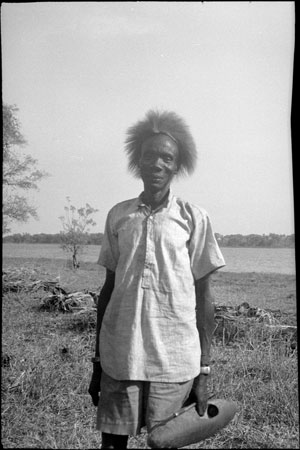Mandari man with headdress and shield

56 x 56 mm | Negative film nitrate
Date of Print:
Unknown
Previous PRM Number:
JB.3.14
Accession Number:
1998.97.106
Description:
A three-quarter length portrait of a Mandari man in European shirt and shorts, standing near a lagoon, wearing an animal hair headdress, and carrying a shield possibly made from ambatch plant and which was commonly used to contain tobacco and other small objects.
Also in the same hand he is probably holding a pipe.
Photographer:
Jean Carlile Buxton
Date of Photo:
1950 - 1952
Region:
[Southern Sudan] Bahr el Jebel Khor Moni
Group:
Mandari Köbora
PRM Source:
Ronald Carlile Buxton via Institute of Social and Cultural Anthropology
Acquired:
Donated 1988
Other Owners:
Jean Buxton Collection
Class:
Ornament , Weapon , Narcotic
Keyword:
Ornament Head , Headdress , Shield , Pipe
Documentation:
See Related Documents File. Buxton field notebooks in Tylor Library.
Other Information:
In Some Notes on the Mandari of Equatoria Province, A.E.
Sudan, (typescript notebook of c.1951 in Tylor Library, Institute of Social and Cultural Anthropology, University of Oxford), book I, page 38-39, Jean Buxton notes that 'Sere [i.e.
Mandari Köbora] women display a wide range of finery...Brightly coloured leather aprons, coloured with red ochre, are ornamented with many rows of red and white beads.
Aprons of metal links are also worn, and with both the above a small skin - more abbreviated than that of the Boronga - is worn, tied round the waist in front and hanging down behind, leaving the front apron showing.
The edges of the skin are often beautifully ornamented with coloured beads...To match the bead 'corselets' of the men, girls wear large 'courting' collars of beads which are hung round the neck and come down in front well over the breasts.
They are usually in orange or red.
Other decorations in the way of necklaces or pendants are worn, of cowry shells, metal rings or beads.
Girls also wear iron and brass rings round arms and legs, similar to those worn by the men.' [Chris Morton 21/1/2005]
Recorder:
Christopher Morton 24/1/2005 [Southern Sudan Project]

